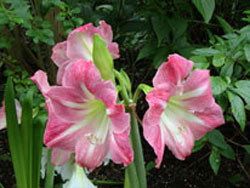
Amaryllis are popular houseplants with massive 6 to 10 inch trumpet shaped flowers and 1 to 2 foot tall stalks. The blooms come in a variety of colors including red, pink, orange, salmon, white and bi-colors. Doubles and miniatures are also available. Because they can produce flowers in mid-winter, they are prized for the color they add to indoor landscapes. Amaryllis may be purchased as bulbs or plants, in or near bloom. Blooming plants are often given and received as gifts.
Amaryllis plants should be kept out of direct sunlight while they are in flower to prolong the life of the flowers.

When growing amaryllis from bulbs, it’s important to select large and healthy bulbs. Larger bulbs will produce more stalks and blooms. Healthy bulbs will be firm and dry with no signs of mold, decay or injury.
Plant amaryllis bulbs in containers that have a hole for drainage and are deep enough to allow for good root development. The container diameter should be about ONE inch larger than that of the bulb. This may seem small, but amaryllis bulbs prefer a smaller container. Select a potting medium that has a high organic matter, but drains well. The bulb should be planted so that one half of the bulb is above the surface of the potting medium. Water the bulb thoroughly and place the container in a warm, sunny spot. Do not fertilize the bulb until it begins to grow. Fertilizing an amaryllis bulb that has no leaves can kill the roots. After growth appears fertilize once or twice a month with a fertilizer recommended for flowering plants.
On standard-sized amaryllis, the flower stem emerges before the leaves, grows rapidly to a height of 12 to 24 inches, and begins a sequence of blooms that last about a month. Move the plant out of direct sunlight when the flower buds have begun to show color, to keep them colorful longer.

The secret to successfully growing amaryllis year after year is to keep the plants actively growing and storing energy in the bulbs after flowering. Once the bloom has faded, cut the flower stem off just above the top of the bulb to prevent the plant from going to seed, but don’t cut the leaves. Water them as you would any houseplant for the remainder of the winter. During the summer, you can keep plants indoors in bright light, or set them outside after all danger of frost is past. You can bury the pots in a partially shaded location and make them part of your outdoor garden. Water the plant from the top of the container thoroughly whenever the top 2 inches of the soil is dry to the touch. Empty any excess water that drains from the pot as wet soil will promote root and bulb rot. Continue to fertilize regularly.
In early September, bring plants indoors, and reduce watering. Store the bulb in its pot, in a dark place like a basement or cool closet (above freezing). Once the foliage has become dry and shriveled, cut the old, yellowed or dried foliage from the bulbs. Watering should be infrequent – only enough to keep the soil from being bone dry all the way to the bottom. After 8-12 weeks of storage, bring the plant back out into the light. As the flower stalk grows, rotate the plant every few days to prevent the stem from leaning towards the light.
Amaryllis plants bloom best when they are potbound so they will require repotting only every 3 or 4 years. The best time to repot them is after they have gone through a dormant period. Follow the same potting procedure as with a newly purchased bulb.
For more information, see the following Planttalk Colorado™ video(s).
For more information, see the following Colorado State University Extension fact sheet(s).



